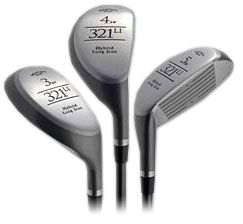DESIGN FIRSTS
HYBRIDS
First Utility Driving Iron WITH HEEL LOCATED, DRAW-BIAS TUNGSTEN WEIGHTING
2000 – Golfsmith XPC3 Driving Iron
In the late 1990s hybrid clubheads had begun to appear as a replacement for low loft irons. As they still are today, the early hybrids were designed to look like a “narrow body fairway wood” with the face to back dimension much greater than that of an iron, but not nearly as wide as a fairway woodhead.
The more narrow and shallow body shape of a hybrid allowed the center of gravity (CG) to be positioned both lower and much farther back from the face than in an iron to help the golfer more easily launch the ball to fly higher than an iron of the same loft. The first hybrid driving irons were popular with a number of players on the professional tours because they were easier to generate a high, soft landing trajectory for long approach shots into greens.
However, because of their lower loft (<20*) average golfers could still slice the ball with a hybrid driving iron. To help reduce this tendency, Tom designed the XPC3 driving irons with a 25g tungsten weight secured on the heel side of the head on the sole. The position of this heavy weight not only kept the CG low, but it also created a draw-bias capability for the clubhead to be able to reduce the golfer’s tendency to push or slice the ball.
First 0.335″ Tip Diameter Hybrid Clubhead and 0.335″ Tip Hybrid Shaft For Assembly to Iron Lengths for Higher Launch
2004 – Wishon Golf 321Li Hybrid Long Irons; Wishon Golf GI-335 Hybrid Shafts
 Hybrid clubs were introduced in the late 1990s to offer golfers an alternative that would be far easier to hit well up in the air to fly than irons of the same low lofts. However, all of the early hybrids were designed to be played with shafts for woods at lengths that were commensurate with fairway wood lengths. The early hybrid clubs ended up being more of a narrow body alternative to fairway woods than a true replacement for low loft irons. The few companies designing hybrids to be the same length as the irons being replaced chose to install iron shafts in the hybrids from a desire to match the hybrid shafts to those of the irons.
Hybrid clubs were introduced in the late 1990s to offer golfers an alternative that would be far easier to hit well up in the air to fly than irons of the same low lofts. However, all of the early hybrids were designed to be played with shafts for woods at lengths that were commensurate with fairway wood lengths. The early hybrid clubs ended up being more of a narrow body alternative to fairway woods than a true replacement for low loft irons. The few companies designing hybrids to be the same length as the irons being replaced chose to install iron shafts in the hybrids from a desire to match the hybrid shafts to those of the irons.
In 2002 when Tom was designing a hybrid clubhead model for the first product line of his own company, his first hybrid heads were designed to be built with an iron shaft. However, initial testing of Tom’s 321Li hybrids with 0.370″ tip diameter iron shafts showed that the clubs were only marginally easer to launch higher than an iron of the same loft.
Having a wealth of experience in shaft research and testing, Tom began to think about the less than desired performance and decided what was needed was a different type of shaft in between a wood and an iron shaft that would not feel as firm as a larger diameter iron shaft, but which could bend more in the lower half of the shaft to help kick the ball higher in the air. As a result, Wishon developed a uniquely different hybrid shaft design with the same tip diameter as a wood shaft but with the stiffness progression up from the tip more similar to an iron shaft.
The smaller tip section allowed the lower half of the shaft to bend more and launch the ball higher in the air. To prevent this smaller tip section of the shaft from making the whole shaft feel too flexible, Tom then increased the stiffness of the upper half of the shaft. The net result of the unique Wishon Golf GI-335 hybrid shafts was to offer golfers a shaft for the 321Li hybrid heads that generated a 3.5 degree higher launch angle than any 0.370″ tip size hybrid shaft, but with the same overall stiffness feel of the larger diameter shafts.
Through the combination of the unique small tip GI-335 iron shaft with the extreme rear-CG design of the 321Li hybrid heads, Tom once again proved his ability to understand the relationship of the clubhead and the shaft to club performance to create a truly easy-to-hit long iron replacement at the same length of the low loft irons being replaced that can be experienced by golfers from the very first shot. Since the GI-335 shaft design, every succeeding hybrid clubhead and hybrid shaft designed by Wishon has been done using the smaller 0.335″ hosel and shaft tip diameter construction.
First 0.830 COR Hybrid
2008 – Wishon Golf 785HF Hybrid Irons
After completing the shallow face, 0.830 COR design of the 949MC fairway woods, Wishon began to speculate whether it might be possible to push the envelope of high COR face design one step farther and create a hybrid clubhead with its COR also at the limit imposed by the Rules of Golf. While hybrid clubs had been introduced to golfers in the late 1990s, as of 2007 no company had yet developed a hybrid with a high COR. Again, because of the smaller face size of a typical hybrid clubhead, the industry believed hybrids could not be designed with a high COR face.
Having designed the first high COR irons in 2004 (770CFE irons) and just completing a fairway wood model with a 32mm face height and a high COR (949MC woods), Wishon believed it could be possible to create a high COR hybrid design. What made this possible was the fact that at the time, hybrid clubheads typically were being designed with a slightly taller face height than most fairway woods. While the width of a typical hybrid face was less than that of a fairway wood, being able to design the face with a little taller face height allowed Wishon to get enough face area that when combined with a very high strength steel alloy (Carpenter TourAlloy 275) formed to a thickness of only 1.6mm, a COR of right under the USGA limit of 0.830 could be achieved.
In addition, very precise robotic welding was utilized to attach the thin face to the hybrid head body so that the width of the welding line could be minimized to allow as much of the face to be able to be deflected inward at impact. The result was the 785HF hybrids which debuted in 2007 as the golf industry’s first high COR hybrid clubhead design.
First Hybrids with a Bendable Hosel for Changing Lie and Face Angle
2011 – Wishon Golf 775HS Hybrids
Another clubhead design breakthrough that originated from Tom Wishon’s commitment to full specifications custom clubfitting was the bendable hosel that debuted in 2011 on Wishon Golf’s 775HS hybrids. Lie angle fitting becomes particularly important on hybrids because of their progressively higher loft.
As with fairway woods, virtually all hybrids were manufactured by investment casting the body, face and hosel as one piece, all made from the same alloy. Since high strength, low ductility steel alloys have been the vastly predominant choice for hybrid head construction since the introduction of hybrids in the 1990s, no hybrid was able to be bent to significantly customize the lie and or face angle. At best a conventional investment cast stainless steel hybrid was only able to be pushed for a 1* change in the lie or face angle.
The secret to the > +/-4* bending capability of the 775HS hybrids was the change to a 4-piece construction method. By forming the crown, sole/skirt, face and hosel pieces separately to be welded together to form the head, Wishon could choose a soft 304 grade stainless steel alloy to make the hosel fully bendable. While Wishon Golf states a limit of +/-4* for bending the hosel of the 775HS hybrids, experienced clubmakers are able to push the hosel more than that when more extreme lie and face angle alterations are necessary to help the golfer play better.

